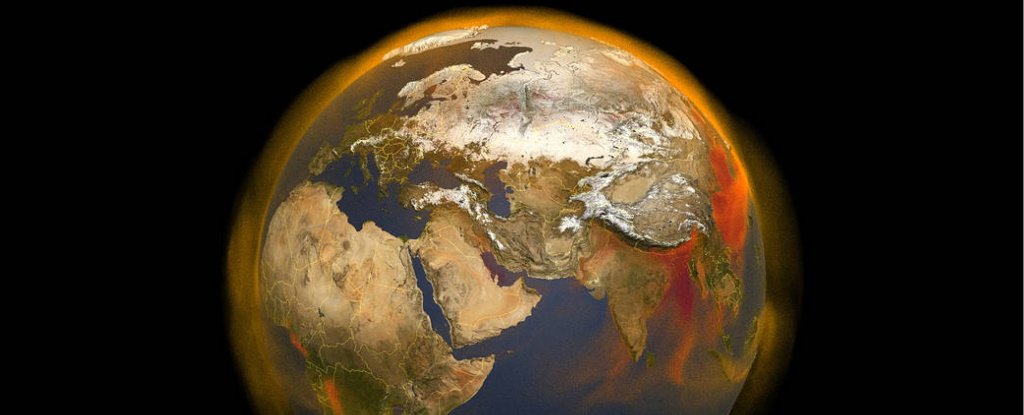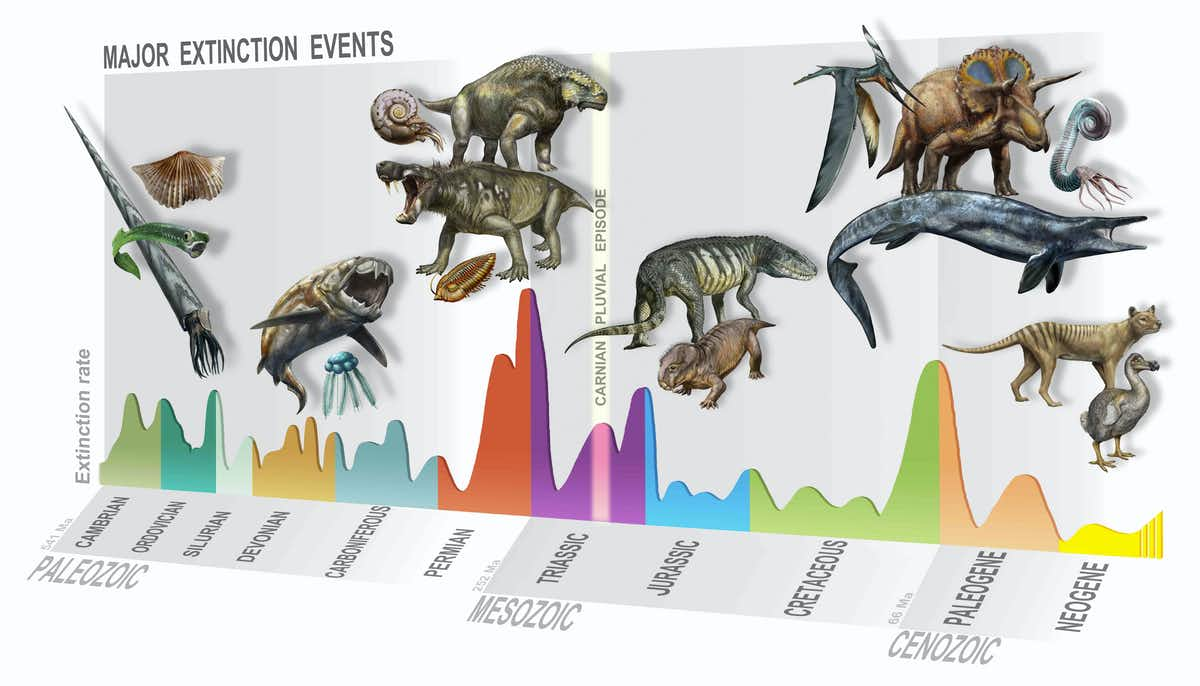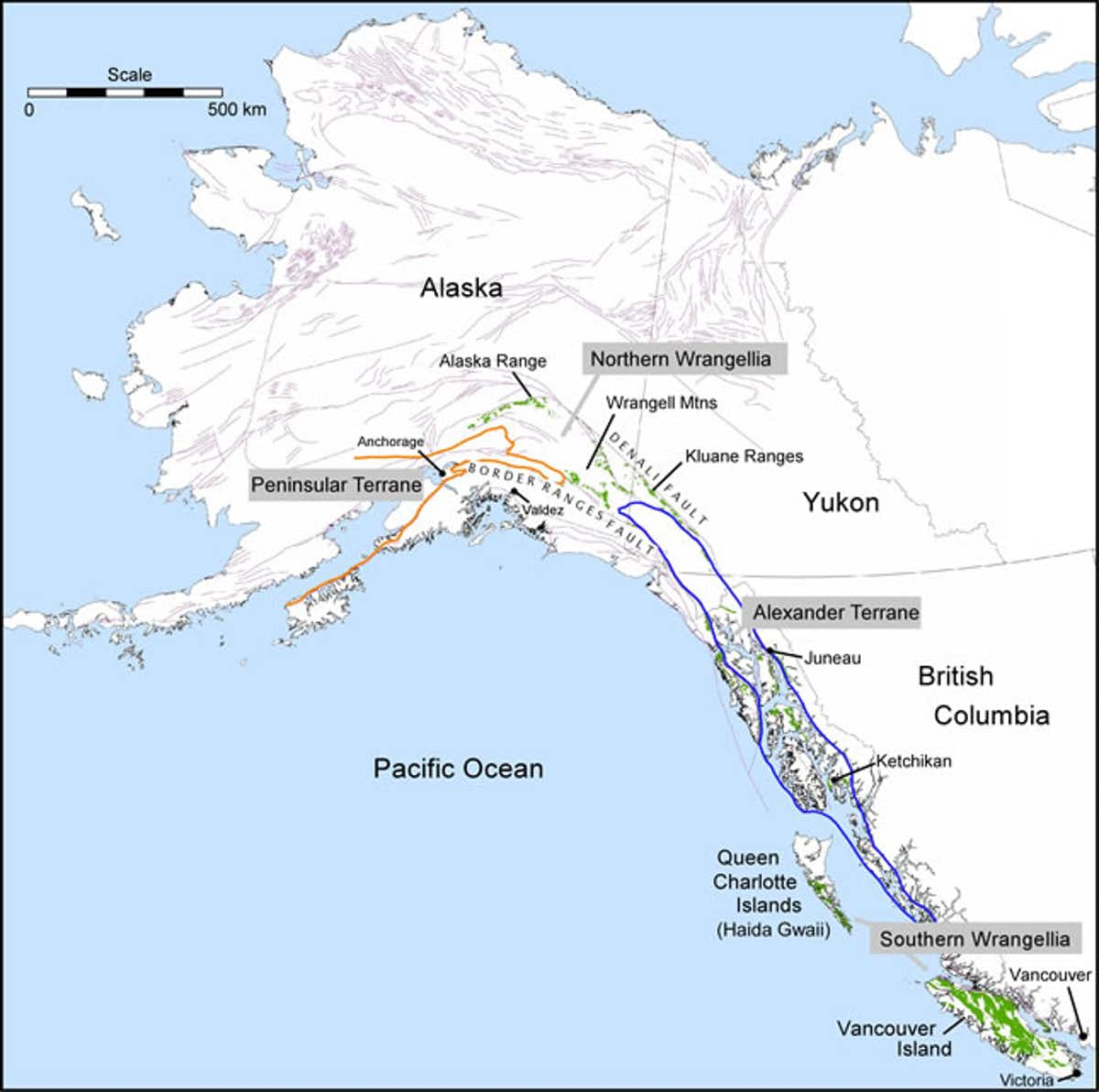
NASA's 3D portrait of methane in 2020. (NASA/Scientific Visualization Studio)
MICHAEL J. BENTON, THE CONVERSATION
25 SEPTEMBER 2020
Huge volcanic eruptions 233 million years ago pumped carbon dioxide, methane, and water vapour into the atmosphere. This series of violent explosions, on what we now know as the west coast of Canada, led to massive global warming.
Our new research has revealed that this was a planet-changing mass extinction event that killed off many of the dominant tetrapods and heralded the dawn of the dinosaurs.
The best known mass extinction happened at the end of the Cretaceous period, 66 million years ago. This is when dinosaurs, pterosaurs, marine reptiles and ammonites all died out.
This event was caused primarily by the impact of a giant asteroid that blacked out the light of the sun and caused darkness and freezing, followed by other massive perturbations of the oceans and atmosphere.
Geologists and palaeontologists agree on a roster of five such events, of which the end-Cretaceous mass extinction was the last. So our new discovery of a previously unknown mass extinction might seem unexpected.
And yet this event, termed the Carnian Pluvial Episode (CPE), seems to have killed as many species as the giant asteroid did. Ecosystems on land and sea were profoundly changed, as the planet got warmer and drier.
On land, this triggered profound changes in plants and herbivores. In turn, with the decline of the dominant plant-eating tetrapods, such as rhynchosaurs and dicynodonts, the dinosaurs were given their chance.
The dinosaurs had originated some 15 million years earlier and our new study shows that, as a result of the CPE, they expanded rapidly in the subsequent 10 million to 15 million years and became the dominant species in the terrestrial ecosystems. The CPE triggered the "age of the dinosaurs" which lasted for a further 165 million years.
It wasn't only the dinosaurs that were given a foothold. Many modern tetrapod groups, such as turtles, lizards, crocodiles and mammals date back to this newly discovered time of revolution.

A timeline of mass extinction events. (D. Bonadonna/MUSE, Trento/Author provided)
Following the clues
This event was first noticed independently back in the 1980s. But it was thought that it was restricted to Europe. First, geologists in Germany, Switzerland and Italy recognised a major turnover among marine faunas about 232 million years ago, termed the Rheingraben event.
Then in 1986, I recognised this independently as a global-scale turnover among tetrapods and ammonites. But at that time, the age dating was much weaker than now and it was impossible to be sure whether these were both the same event.
The jigsaw pieces started falling into place when an episode of about 1 million years of humid climates was recognised throughout the UK and parts of Europe by geologists Mike Simms and Alastair Ruffell. Then geologist Jacopo dal Corso spotted a coincidence in timing of the CPE with the peak of eruptions of the Wrangellia basalts.
Wrangellia is a term geologists give to a narrow tectonic plate that is attached to the west coast of the North American continent, north of Vancouver and Seattle.
Finally, in a review of the evidence from Triassic-aged rocks, the signature of the CPE was detected – not only in Europe, but also in South America, North America, Australia and Asia. This was far from being a Europe-only event. It was global.

Following the clues
This event was first noticed independently back in the 1980s. But it was thought that it was restricted to Europe. First, geologists in Germany, Switzerland and Italy recognised a major turnover among marine faunas about 232 million years ago, termed the Rheingraben event.
Then in 1986, I recognised this independently as a global-scale turnover among tetrapods and ammonites. But at that time, the age dating was much weaker than now and it was impossible to be sure whether these were both the same event.
The jigsaw pieces started falling into place when an episode of about 1 million years of humid climates was recognised throughout the UK and parts of Europe by geologists Mike Simms and Alastair Ruffell. Then geologist Jacopo dal Corso spotted a coincidence in timing of the CPE with the peak of eruptions of the Wrangellia basalts.
Wrangellia is a term geologists give to a narrow tectonic plate that is attached to the west coast of the North American continent, north of Vancouver and Seattle.
Finally, in a review of the evidence from Triassic-aged rocks, the signature of the CPE was detected – not only in Europe, but also in South America, North America, Australia and Asia. This was far from being a Europe-only event. It was global.

The distribution of Wrangellia flood basalts in Alaska, Yukon and British Columbia. (University of British Columbia/EOAS)
Volcanic eruptions
The massive Wrangellia eruptions pumped carbon dioxide, methane and water vapour into the atmosphere, leading to global warming and an increase in rainfall worldwide. There were as many as five pulses of eruptions associated with warming peaks from 233 million years ago.
The eruptions led to acid rain as the volcanic gases mixed with rainwater to shower the Earth in dilute acid. Shallow oceans also became acidified.
The sharp warming drove plants and animals from the tropics and the acid rain killed plants on land, while ocean acidification attacked all marine organisms with carbonate skeletons. This stripped away the surfaces of the oceans and the land.
Life may have begun to recover, but when the eruptions ceased, temperatures remained high while the tropical rainfall ceased. This is what caused the subsequent drying of the land on which the dinosaurs flourished.
Most extraordinary was the re-casting of the marine carbonate factory. This is the global mechanism by which calcium carbonate forms great thicknesses of limestones and provides material for organisms like corals and molluscs to build their shells.
The CPE marked the start of modern coral reefs, as well as many of the modern groups of plankton, suggesting profound changes in ocean chemistry.
Before the CPE, the main source of carbonate in the oceans came from microbial ecosystems, such as limestone-dominated mud mounds, on continental shelves.
But after the CPE, it was driven by coral reefs and plankton, where new groups of micro-organisms, such as dinoflagellates, appeared and bloomed. This profound switch in fundamental chemical cycles in the oceans marked the beginning of modern marine ecosystems.
And there are going to be important lessons for how we help our planet recover from climate change. Geologists need to investigate the details of the Wrangellia volcanic activity and understand how these repeated eruptions drove the climate and changed the Earth's ecosystems.
There have been a number of volcanically-induced mass extinctions in the history of the Earth and the physical perturbations, such as global warming, acid rain and ocean acidification, are among the challenges we see today.
Palaeontologists will need to work more closely on the data from marine and continental fossil records. This will help us understand how the crisis played out in terms of the loss of biodiversity, but also to explore how the planet recovered.

Michael J. Benton, Professor of Vertebrate Palaeontology, University of Bristol.
This article is republished from The Conversation under a Creative Commons license. Read the original article.
No comments:
Post a Comment